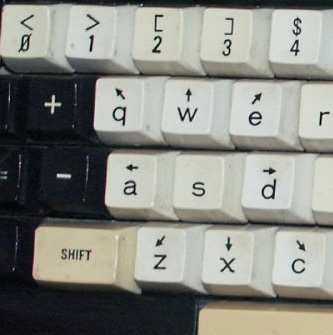In anticipation of my next keyboard, I have been doodling layouts of the non-alpha layers, as one does. Today let’s discuss arrow keys.
Regular users of vi often arrange them as in that editor:
| h ← | j ↓ | k ↑ | l → |
although they often have other letters in those positions. They may shift this row one step to the right so that all arrows are on home keys. On another row they place these loosely analogous keys:
| home | page down | page up | end |
Others prefer the inverted T arrangement of traditional fullsize boards, known to videogamers as WASD:
| ↑ | |||
| ← | ↓ | → |
and fill the adjacent slots thus:
| home | ↑ | end | page up |
| ← | ↓ | → | page down |
Another possibility:
| ↑ | home | end | page up |
| ↓ | ← | → | page down |
I first honed my typing speed on the PLATO IV keyboard, which had symmetrical arrows:

Oblique arrow keys are not available to me now, but I can try this:
| ↑ | page up | ||
| ← | home | → | end |
| ↓ | page down |
though I am prepared to learn that this (or indeed one of the above) is easier to keep straight:
| ↑ | page up | ||
| ← | → | home | end |
| ↓ | page down |
I have mostly filled in four layers of my (so far hypothetical) three-row keeb:
I have avoided assigning the outer pinky columns, to decide later whether I’ll need them when I get around to designing a board to fit my hands as well as can be, incorporating a trackball or other pointer. Small is beautiful, baby.
The next layer will be macros, once I learn macros in QMK.
Then a layer (may need two) for my favorite non-ASCII characters: bits of the International Phonetic Alphabet; soft hyphen and zero-width space; math; arrows (aligned to the cursor layer); card suits; musical symbols; probably some accented letters (which I can type without using layers, but a layer can be quicker).
On second thought the mouse and cursor keys must not be on the same layer as anything that might be used with modifiers (shift, command, option, control). This is because of “tap-hold”: I get modifiers by holding a home key on the opposite hand, which when merely tapped makes a letter. This means giving up the ability to repeat a key by holding, which I never do with letters but often do with cursors.
By the same token, cursors and mouse cannot split one layer, because each often needs modifiers. So they can share layers with Unicode, and digits will share with Fn.
I had in mind a separate mouse layer, with two interlaced quartets as on the arrow layer described above. But MacOS does not recognize mouse wheel keys, so I have three compasses rather than four. So it makes more sense to put them in parallel rows on one layer: ← ↑ ↓ → on home keys, Home PgUp PgDn End above them, and mouse below.
Instead of three parallel rows of four, I could have an S-tetromino (resembling the Wordstar arrows) between two L-tetrominos. But that seems a bit silly.
I find the mouse keys less useful than I had imagined, making half the question moot. My cursor layer’s other half has modifier keys (no tap-hold here), ⌘Z ⌘X ⌘C ⌘V (because my base layer does not have those letters in the same places), and audio controls.
There’s one more arrangement of the arrow keys that is historically very important and so you shouldn’t forget about it: the Wordstar layout. R: page up, C: page down, E: up, X: down, A: previous word, F: next word, S: left, D: right. In Wordstar and lots of other interfaces that it’s inspired, you press these letters (on a qwerty keyboard) together with the ctrl modifier for the navigation functions.
I did use Wordstar a little bit – and now I cannot recall in what context!
At present, instead of a separate layer, I have cursors on chords: each is two of a chosen square of keys.